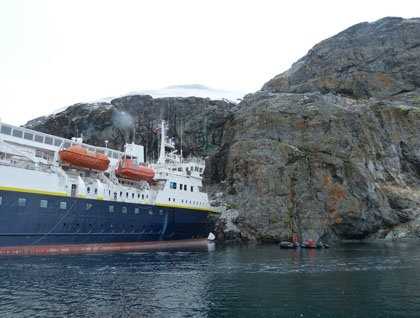We have anticipated this moment for months, for years, for a lifetime, and now we are here. Antarctica: the mysterious continent. We are proceeding southward along the west coast of the Antarctic Peninsula. This is the windward side of the Peninsula. Moist winds coming from the adjacent Bellinghausen Sea dump their snow on steep mountain slopes. The accumulating mass transforms the snow into the ice that forms the glaciers flowing down to the sea. Peninsula glaciers are short and steep. As they descend over irregular terrain, the glacier surface forms deep crevasses, and intersecting crevasses form the large blocks that we call seracs. We can only imagine the Antarctic explorers struggling up a crevassed glacier to reach the Polar Plateau above, on their way to the South Pole.
We spent the morning in Paradise, that is, in Paradise Harbour, so named by early 20th-century whalers. It is a well-protected anchorage (for whaling vessels and for the National Geographic Explorer) between the Antarctic Peninsula to the east, and a set of snow-covered islands. In an incredible feat of seamanship, the Captain nestled the bow of the ship against the rocks and we disembarked to cruise over the icy water, either by our Zodiacs or by our yellow, two-person, inflatable kayaks.
We continued southward, passing through the famously scenic LeMaire Channel, with the Peninsula to our port side, and Booth Island to starboard. Today her beauty was muted by a low ceiling. Rounding Booth Island, we stopped for further exploration. The relatively shallow water here captures giant icebergs. We call it "the graveyard of the icebergs". It is best explored by Zodiac, and so we did. The icebergs gradually erode, taking on an endless variety of shapes and textures. Some have clearly rolled, so the surfaces now exposed show the pock-marked texture that forms when the ice is under water. Others form arches, spires, and ice-enclosed lagoons. With luck, a minke whale is spotted making a quick appearance as it darts around and between the ice.
We also had the opportunity to walk up the snowy slope of Booth Island, passing lines of gentoo penguins and the occasional chinstrap as they headed downslope to the sea to feed, or returned with a load of krill to be delivered to their hungry young. While the parents are away feeding, the downy young penguins gather in a group called a creche, the better to fend off marauding skuas. When an adult returns with food, it must pick its own young from the group. Every young penguin wants to claim every adult as its own. The parent responds by running away from the creche, with a line of young birds in pursuit. One by one, the imposter young give up the chase. Once the parent bird has isolated its own young, it turns to feed. Back and forth, to the sea and back to the waiting young. It takes all of the efforts of two penguins, male and female, to raise their one or two chicks. They had best be quick, for winter is on its way, and they must complete their parental duties and then replace their old and warn feathers with a new set, before winter arrives in force.







